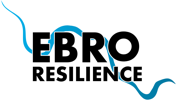The LIFE Ebro Resilience P1 project has received the annual visit of the monitor of the ELMEN consultancy, Borja Domíguez, who represents the tutors of the LIFE program of the European Union to carry out a general review of the project.
This week we have reviewed the status of all the actions and have anticipated the main milestones for the coming months, in addition to resolving possible doubts.
The conference included an initial session on the 21st with the technical presence of all the partners Ebro Hydrographic Confederation (CHE); Government of La Rioja; Government of Navarra, through Gestión Ambiental de Navarra, S.A. (GAN-NIK); Government of Aragon, Aragonese Water Institute, TRAGSA and TRAGSATEC, which was held at the headquarters of the CHE, in Zaragoza.

In addition, technical visits were made to the two intervention areas. The first, on the afternoon of Tuesday, 22, to section 2, between Osera de Ebro and Fuentes de Ebro (Zaragoza), where the progress of the adaptation of the irrigation infrastructure of the Huerta del Ebro Irrigation Community was checked and the implementation area of the future Lateral Flow Buffer Zones was visited.
Pilot project
In this area, a novel intervention is proposed to make an intensively cultivated agricultural area compatible with the passage of floods.


For this purpose, the creation of lateral flow buffer zones has been planned. These buffer zones will compartmentalize farms into areas that will be pre-flooded just before the levees overflow, creating water buffers that will minimize damage to farms and infrastructure.
In addition, the capacity of the riverbed will be increased by recovering fluvial space through the recessing of two sections of the defense dike. These new river areas will be environmentally restored.
The works for the implementation of the lateral flow buffer zones and the recovery of fluvial space will be undertaken by TRAGSA under the direction of the CHE. The Government of Aragon will carry out the adaptation of the irrigation system and environmental restoration.
Alfaro-Castejón
On the following day, the interventions in the meander of La Roza, in Alfaro (La Rioja) were visited; the opening of arms in the soto de Alfaro, recently started, and the area of future action in the Soto del Señorío, in Castejón (Navarra).


The actions, integrated in the so-called combined section of actions, will have a positive effect on more than 500 hectares of agricultural use, reducing the risk of flooding and allowing the recovery of 60 hectares of river space.
The proposal consists of the sum of shares such as the reconnection of meanders, the creation of relief channels, the recovery of old river branches and the enlargement of the river space, together, offer an overall benefit with respect to flood risk and the environmental condition of the river.measurable at section level.
- Soto de Alfaro(or Soto de Tamarigal): action for the recovery of river branches.
- Morphological adaptation of theLa Roza meander, in Alfaro, La Rioja , executed in the absence of environmental restoration and planting, which includes the recovery of 22 hectares of fluvial space and has involved a defense setback, the creation of a relief channel and a wetland. In addition, the hydraulic capacity of the railroad bridge has been improved in this section.
- Morphological adaptation of the El Señorío meander, in Castejón, Navarra, also scheduled for 2024, where 23 hectares of river space will be recovered through the recessing of defenses and the creation of a relief channel.
Positive Balance
During these days, some of the strong points of the project have been verified, in addition to the technical actions themselves:
- Coordination between partners
- The replicability of these measures in other watercourses, in the Ebro basin or in Spanish and European basins.
- A firm commitment to participation and social capacity building


